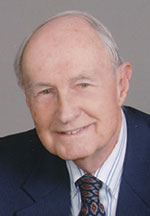Reflection / John F. Fink
The luminous mysteries of the rosary tell us just who Jesus was
 While praying the rosary on a recent Thursday, I found myself marveling at the wisdom of St. Pope John Paul II for adding the luminous mysteries to the rosary.
While praying the rosary on a recent Thursday, I found myself marveling at the wisdom of St. Pope John Paul II for adding the luminous mysteries to the rosary.
As we were growing up, we had only the joyful, sorrowful and glorious mysteries. That meant that we jumped from finding Jesus in the Temple when he was 12 to the agony in the garden, and the beginning of his passion, when he was about 33. We skipped all that Jesus did during his public life. Pope John Paul knew that wasn’t right. Indeed, the luminous mysteries give us the same lesson that the Apostles received.
They are called the luminous mysteries because they slowly shed light on just who Jesus was. Just by meditating on those mysteries, we can reconstruct Jesus’ life story up to the time of the sorrowful mysteries. I think of the story like this:
When Jesus was about 30 years old, he and his Father decided it was time for him to start fulfilling the reason he came to Earth—to redeem humankind. To do that, the first thing he had to do was leave the little village of Nazareth and become better known. He knew that his cousin, John the Baptist, was preparing people for the Messiah’s coming, so he went to where John was baptizing. As John baptized Jesus, the voice of God told us, “This is my beloved Son, with whom I am well pleased” (Mt 3:17). (First luminous mystery.)
With John’s support, Jesus began to attract a few followers: Andrew and Peter, James and John, a few others. But he had promised his mother that he would be in Cana of Galilee for a wedding, and he kept that promise. That’s when his mother decided that Jesus’ “hour had come,” and encouraged him to change a large amount of water into wine, both of them realizing that such an act would forever prevent him from simply returning to life in Nazareth. (Second luminous mystery.)
So he moved to the relatively large town of Capernaum, where he lived with Peter and his family when he was there. But he wasn’t there a lot. He and the 12 men he chose as Apostles began traveling around the area, proclaiming the kingdom of God. (Third luminous mystery.) He worked miracles of healing, which no ordinary human could do. But he also multiplied food, walked on water, calmed storms, and expelled demons. Just who was this man?
That’s what the Apostles wondered. Jesus was trying to teach them during their travels as well as in Peter’s home, which has been called the first seminary. But they just weren’t quite getting it, especially when Jesus told them that he had to go to Jerusalem where he would be crucified. So Jesus led them on a long trip, from Tyre and Sidon in Lebanon to Caesarea Philippi in the mountains north of the Sea of Galilee.
This is where he asked the Apostles who they thought he was. Peter replied, “You are the Messiah, the Son of the living God” (Mt 16:16). Jesus was pleased with this answer because he said, “Blessed are you, Simon son of Jonah. For flesh and blood has not revealed this to you, but my heavenly Father” (Mt 16:17).
Peter was almost there, but not quite. So six days later, Jesus took Peter, James and John up a high mountain where he was transfigured before them. (Fourth luminous mystery.) His clothes became dazzling white, and his face shone like the sun. A voice from heaven repeated what it had said at his baptism, “This is my beloved Son in whom I’m well pleased” (Mt 17:5), but this time it added, “Listen to him” (Mt 17:5). Surely, all this was enough to convince the Apostles that Jesus was God.
Now Jesus had to prepare the Apostles for his crucifixion, leading to the sorrowful mysteries of the rosary. But Pope John Paul added still another luminous mystery, the institution of the Eucharist, Jesus’ plan to be with his Church after his death and resurrection. (Fifth luminous mystery.)
What a blessing it was that Pope John Paul gave us these luminous mysteries for meditation while saying the rosary.
(John F. Fink is editor emeritus of The Criterion.) †
 While praying the rosary on a recent Thursday, I found myself marveling at the wisdom of St. Pope John Paul II for adding the luminous mysteries to the rosary.
While praying the rosary on a recent Thursday, I found myself marveling at the wisdom of St. Pope John Paul II for adding the luminous mysteries to the rosary.